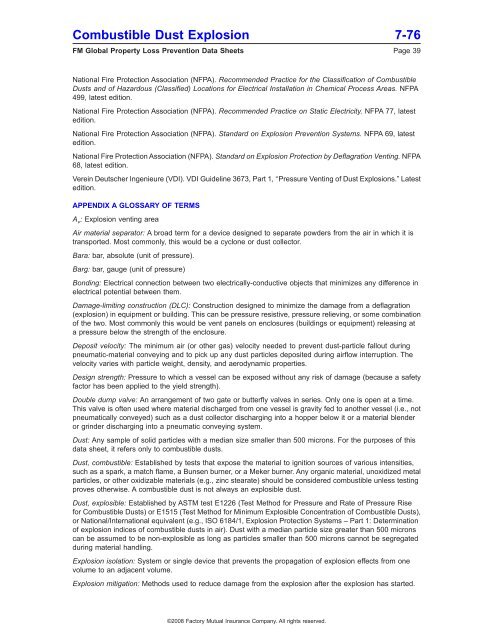DS 7-76 Prevention and Mitigation of Combustible Dust ... - FM Global
DS 7-76 Prevention and Mitigation of Combustible Dust ... - FM Global
DS 7-76 Prevention and Mitigation of Combustible Dust ... - FM Global
Create successful ePaper yourself
Turn your PDF publications into a flip-book with our unique Google optimized e-Paper software.
<strong>Combustible</strong> <strong>Dust</strong> Explosion 7-<strong>76</strong><br />
<strong>FM</strong> <strong>Global</strong> Property Loss <strong>Prevention</strong> Data Sheets Page 39<br />
National Fire Protection Association (NFPA). Recommended Practice for the Classification <strong>of</strong> <strong>Combustible</strong><br />
<strong>Dust</strong>s <strong>and</strong> <strong>of</strong> Hazardous (Classified) Locations for Electrical Installation in Chemical Process Areas. NFPA<br />
499, latest edition.<br />
National Fire Protection Association (NFPA). Recommended Practice on Static Electricity. NFPA 77, latest<br />
edition.<br />
National Fire Protection Association (NFPA). St<strong>and</strong>ard on Explosion <strong>Prevention</strong> Systems. NFPA 69, latest<br />
edition.<br />
National Fire Protection Association (NFPA). St<strong>and</strong>ard on Explosion Protection by Deflagration Venting. NFPA<br />
68, latest edition.<br />
Verein Deutscher Ingenieure (VDI). VDI Guideline 3673, Part 1, ‘‘Pressure Venting <strong>of</strong> <strong>Dust</strong> Explosions.” Latest<br />
edition.<br />
APPENDIX A GLOSSARY OF TERMS<br />
A v: Explosion venting area<br />
Air material separator: A broad term for a device designed to separate powders from the air in which it is<br />
transported. Most commonly, this would be a cyclone or dust collector.<br />
Bara: bar, absolute (unit <strong>of</strong> pressure).<br />
Barg: bar, gauge (unit <strong>of</strong> pressure)<br />
Bonding: Electrical connection between two electrically-conductive objects that minimizes any difference in<br />
electrical potential between them.<br />
Damage-limiting construction (DLC): Construction designed to minimize the damage from a deflagration<br />
(explosion) in equipment or building. This can be pressure resistive, pressure relieving, or some combination<br />
<strong>of</strong> the two. Most commonly this would be vent panels on enclosures (buildings or equipment) releasing at<br />
a pressure below the strength <strong>of</strong> the enclosure.<br />
Deposit velocity: The minimum air (or other gas) velocity needed to prevent dust-particle fallout during<br />
pneumatic-material conveying <strong>and</strong> to pick up any dust particles deposited during airflow interruption. The<br />
velocity varies with particle weight, density, <strong>and</strong> aerodynamic properties.<br />
Design strength: Pressure to which a vessel can be exposed without any risk <strong>of</strong> damage (because a safety<br />
factor has been applied to the yield strength).<br />
Double dump valve: An arrangement <strong>of</strong> two gate or butterfly valves in series. Only one is open at a time.<br />
This valve is <strong>of</strong>ten used where material discharged from one vessel is gravity fed to another vessel (i.e., not<br />
pneumatically conveyed) such as a dust collector discharging into a hopper below it or a material blender<br />
or grinder discharging into a pneumatic conveying system.<br />
<strong>Dust</strong>: Any sample <strong>of</strong> solid particles with a median size smaller than 500 microns. For the purposes <strong>of</strong> this<br />
data sheet, it refers only to combustible dusts.<br />
<strong>Dust</strong>, combustible: Established by tests that expose the material to ignition sources <strong>of</strong> various intensities,<br />
such as a spark, a match flame, a Bunsen burner, or a Meker burner. Any organic material, unoxidized metal<br />
particles, or other oxidizable materials (e.g., zinc stearate) should be considered combustible unless testing<br />
proves otherwise. A combustible dust is not always an explosible dust.<br />
<strong>Dust</strong>, explosible: Established by ASTM test E1226 (Test Method for Pressure <strong>and</strong> Rate <strong>of</strong> Pressure Rise<br />
for <strong>Combustible</strong> <strong>Dust</strong>s) or E1515 (Test Method for Minimum Explosible Concentration <strong>of</strong> <strong>Combustible</strong> <strong>Dust</strong>s),<br />
or National/International equivalent (e.g., ISO 6184/1, Explosion Protection Systems – Part 1: Determination<br />
<strong>of</strong> explosion indices <strong>of</strong> combustible dusts in air). <strong>Dust</strong> with a median particle size greater than 500 microns<br />
can be assumed to be non-explosible as long as particles smaller than 500 microns cannot be segregated<br />
during material h<strong>and</strong>ling.<br />
Explosion isolation: System or single device that prevents the propagation <strong>of</strong> explosion effects from one<br />
volume to an adjacent volume.<br />
Explosion mitigation: Methods used to reduce damage from the explosion after the explosion has started.<br />
©2008 Factory Mutual Insurance Company. All rights reserved.

















